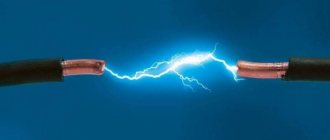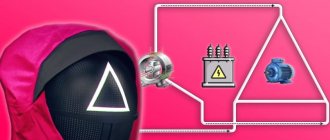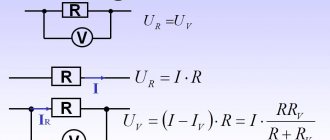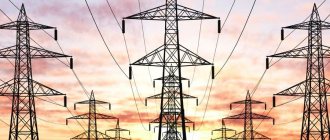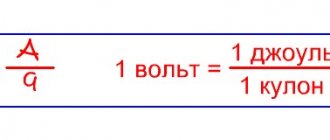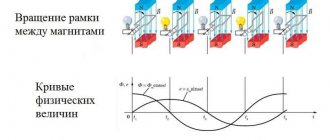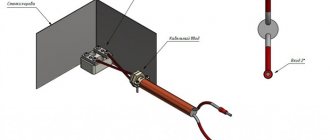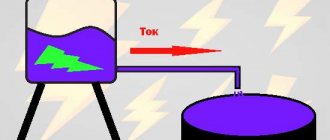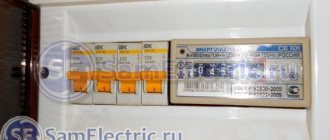Household electrical distribution networks mainly use one phase and a neutral conductor. This is enough to operate household electrical appliances, lighting and heating. To organize the production process, three-phase current is used. Consumers, busbar assemblies, distribution panels, metering units and the entire electrical circuit are configured to operate from three-phase current networks.
Three-phase current
Three-phase AC system
Three-phase system networks are designed for power from substations that supply voltage through four wires: three phases and zero. This is one of the special cases of multiphase circuits where EMFs operate, having sinusoidal shapes and equal frequency. They are produced by the same source, but have a phase angle of 120 degrees (2π/3).
Another electrical engineer M.O. Dolivo-Dobrovolsky, while studying the operation of asynchronous motors, presented a four-wire system as a working system for powering this type of machines and units. Each wire that forms a separate circuit within this system is called a “phase”. The structure of three phase-shifted alternating currents is called three-phase current.
Four-wire power circuit
Important! In such a structure, the phase voltage is 220 V - this is what the device will show when measuring between the phase and neutral conductors. The linear voltage will be 380 V when measuring between two phase current conductors.
Summarize
From all of the above, we can conclude that the phase voltage in a 0.4 kV network is always 220 V, while the linear voltage is 380 V. However, one should not assume that if the phase voltage is lower, it becomes less dangerous. The editors of Homius declare with full responsibility that electric shock can be fatal, regardless of whether the voltage in the circuit is line or phase. After all, damage to tissues and organs is caused not by the voltage itself, but by the current strength. For example, 220 V transformed into 36 V becomes even more dangerous. After all, a person practically does not feel such a low voltage, and at this time the current affects the organs. Therefore, when performing electrical installation work, one should not forget about safety precautions.
PHOTO: metodist.siteMemo for a novice electrician
Previous EngineeringHow to choose the right stove for the garage: studying modern types of heating equipment Next EngineeringSink for the kitchen: how to choose a sink, what to look for
No tags for this post.
What is three-phase current
Three-phase network power calculation
This is a system that combines three electrical circuits with currents that differ in phase by 1/3 of a period. Moreover, their own EMFs coincide in frequency and amplitude and have the same phase shift. For such a structure, the phase and line voltages are respectively 220 V and 380 V. The frequency of periodic oscillations is 50 hertz (Hz).
If you connect current sinusoidal signals from a three-phase network to an oscilloscope, you will see that they pass through their maximum points in a regular phase sequence.
The general formula for AC power is:
P = I*U*cosϕ,
Where:
- P – power, (W);
- I – current, (A);
- U – voltage, (V);
- cosϕ – power factor.
The cosϕ value should tend to unity. The average power factor lies in the range of 0.7-0.8. The higher it is, the greater the efficiency of the installation.
In the case of 3-phase networks, the power will depend on the connection diagram of the source and load.
Three-phase current graph
Why use three-phase current
Knowing what three-phase current is, you can clearly answer the question why it is used.
How to connect a three-phase electric motor to a 220V network
Three-phase AC systems have a number of advantages that allow them to stand out among the multi-phase construction of electrical structures. The advantages include the following features:
- economical transportation of energy over long distances without reducing parameters;
- 3-phase transformers and cables have lower material consumption, unlike single-phase models;
- the ability to ensure a balanced energy system;
- simultaneous presence in installations of two voltages for operation: phase voltage (220 V) and linear voltage (380 V).
For your information. Connecting fluorescent lamps to different phases and installing them in one lamp will significantly reduce the stroboscopic effect and flicker noticeable to the eye.
An integral part of the equipment of any manufacturing enterprise are asynchronous motors. For their normal operation and development of rated power, 3-phase power is required. It provides the possibility of forming a rotating MF (magnetic field), which drives the rotor of an asynchronous machine. Such motors are more economical, easier to manufacture and easy to operate compared to single-phase or any other.
At power plants of any type (hydroelectric power plant, nuclear power plant, thermal power plant), as well as alternative ones, the production of variable-type electricity is ensured using generators.
Three-phase power line 10 kV
When is it 380 and when is it 220?
So why do we have a voltage of 220 V in our apartments and not 380? The fact is that, as a rule, consumers with a power of less than 10 kW are connected to one phase. This means that one phase and a neutral (zero) conductor are introduced into the house. This is exactly what happens in 99% of apartments and houses.
Single-phase electrical panel in the house. The right machine is introductory, then through the rooms. Who can find mistakes in the photo? Although, this shield is one big mistake...
However, if you plan to consume power more than 10 kW, then a three-phase input is better. And if you have equipment with three-phase power supply (containing three-phase motors), then I strongly recommend introducing a three-phase input into the house with a linear voltage of 380 V. This will save on wire cross-section, on safety, and on electricity.
Three-phase input. Input machine for 100 A, then - to a three-phase direct connection meter Mercury 230.
Despite the fact that there are ways to connect a three-phase load to a single-phase network, such modifications sharply reduce the efficiency of motors, and sometimes, all other things being equal, you can pay 2 times more for 220 V than for 380.
Single-phase voltage is used in the private sector, where power consumption, as a rule, does not exceed 10 kW. In this case, a cable with wires with a cross section of 4-6 mm² is used at the input. The current consumption is limited by the input circuit breaker, the rated protection current of which is no more than 40 A.
I already wrote about choosing a circuit breaker here. And about the choice of wire cross-section - here. There are also heated discussions of issues.
But if the consumer’s power is 15 kW or higher, then three-phase power must be used. Even if there are no three-phase consumers in this building, for example, electric motors. In this case, the power is divided into phases, and the electrical equipment (input cable, switching) does not bear the same load as if the same power was taken from one phase.
An example of a three-phase electrical panel. Consumers are both three-phase and single-phase.
For example, 15 kW is about 70A for one phase; you need a copper wire with a cross-section of at least 10 mm². The cost of a cable with such cores will be significant. But I have never seen single-phase (single-pole) circuit breakers with a current greater than 63 A on a DIN rail.
Therefore, in offices, stores, and especially in enterprises, only three-phase power is used. And, accordingly, three-phase meters, which come in direct connection and transformer connection (with current transformers).
How does a generator work?
Three-phase meter: selection, installation, connection
The device works by converting rotational energy into electrical energy. The electric machine, using the rotation of the MP, generates electric current. At the moment when the wire winding (coil) rotates in the MF, the magnetic field lines penetrate the turns of the winding.
Attention! As a result of this process, electrons move towards the positive pole of the magnet. In this case, the current moves, on the contrary, towards the negative magnetic pole.
It doesn’t matter what rotates under mechanical action, a winding or a magnetic field, the current will flow as long as the rotation is performed.
Generators producing three-phase voltage may have:
- fixed magnets and a movable (rotating) armature;
- a stationary stator and magnetic poles that rotate.
In devices of the first design, there is a need to draw a large current at a high voltage. To do this, you have to use brushes (contacts sliding along slip rings).
The second generator structure is simpler and more in demand. Here the rotor is a moving element and consists of magnetic poles. The stator is a stationary part, assembled from a package of iron sheets insulated with each other and inserted into the grooves of the stator winding.
Information. The rotor has a body made of solid iron and has magnetic poles in the form of tips. Tips are assembled from separate sheets. Their shape is selected so that the generated current is close to a sinusoid in shape.
Pole cores have field coils. The coils are supplied with direct current. The feed is carried out through graphite brushes to the contact rings located on the shaft.
In the diagrams, a 3-phase generator is drawn as three windings, the angle between which is 1200.
There are several ways to excite generators, namely:
- independent - using a battery;
- from the exciter - using an additional generator mounted on one shaft;
- due to self-excitation - its own rectified current.
This also includes magnetic excitation supplied from permanent magnets.
Three-phase alternator
Reason for Edison's loss
There is often an opinion that Tesla's system turned out to be better, so Edison lost. It is difficult to say how many dollars the latter lost, but by modern standards he defrauded Nikola by 4.5 million dollars. Inflation! The authors are inclined to believe that Edison got his way. Nikola Tesla was able to prove the advantages of direct current. For example, the latter is less prone to corona on wires; the amplitude does not contain sharp surges.
Today it has been proven that it is more profitable to transmit direct current over long distances. This excludes network reactances – inductance and capacitance – from consideration. Which significantly reduces unstable reactive power. The 21st century is capable of becoming the second birth of direct current for transmitting it over long distances. But Edison's inability to transfer energy causes laughter. Tesla had the right to help, then DC devices today would be used on an equal basis with AC consumers. For commutator motors this is better - efficiency and torque increase.
It turns out that it is beneficial to transmit direct current. Edison simply could not find the right solution; he tried to take on the task hastily, without diving into the rear. Edison was a pure practitioner and did not know how to find such clever solutions as converters. But all generators of the mid-19th century had a built-in commutator for rectification. All that remained was to connect it to the line and carry out the conversion on the receiving side. That's all! Nikola brilliantly punished Edison, proving the presence in the world of a certain force that controls the course of history.
alternating current was chosen due to the availability of a powerful means of transmission. We're talking about a transformer. First designed in 1831 (or earlier) by Michael Faraday, this indispensable element of modern technology has remained without the attention it deserves. Heinrich Ruhmkorff returned interest in the device fifteen years later, using a dynamo to produce a discharge in the spark gap. A step-up transformer greatly enhanced the effect. This directly opened the way for scientists to conduct experiments, but the essence of the transformation did not receive the attention it deserved.
Instead, scientists persisted in working on direct current. By creating engines, lighting devices and generators for it. It’s surprising, knowing about the reversibility of electric machines, they didn’t figure out how to create a unipolar motor, which is used today in hand mixers and blenders. In fact, household motors are single-phase. And only a small part operates on direct current.
Let's point out an implicit advantage. DC has a higher safety limit. It seems possible to make industrial networks harmless to people. Let us consider the statement in more detail; the arguments are not obvious to the inexperienced reader.
Biasing and 3-phase voltage generation
Three-phase circuit diagrams
The windings of a generator or transformer in three-phase circuits can be connected to each other according to two schemes:
- star;
- triangle.
Connections are made on the terminal block (boron) of the unit or transformer, where the ends of the windings are brought out.
Jumper connection of windings
Connecting the load to the generator (transformer) can be done according to the following schemes:
- star-star connection using a neutral conductor;
- star-star connection without using a neutral wire;
- star-delta connection;
- "triangle-triangle" scheme;
- delta-star connection.
Attention! This variety of circuits is due to the fact that the generator's own windings and the load's own windings can be connected in different ways. With different types of coupling, different correspondences between phase and linear values are obtained.
The connection can be made at the factory when assembling the generator; the second ends of the windings are already brought out to the point where the power cable is connected. Information about the winding connection diagram is applied to a plate attached to the stator of the machine.
On electric motors, transformers or other consumers, the necessary manipulations are also performed to switch winding terminals. In the picture below, the ends of the windings connected by a jumper are marked with a red marker. Blue marker - power phases.
Connections on boron motor
Star connection
The letter designation of the beginning of the windings is “A”, “B”, “C”, the ends are “X”, “Y”, “Z”. The zero point is marked “O”. Each winding has two ends. When connecting “star”, all three winding terminals of the same name (beginning) are connected to each other at one point “O”. The load is connected to the free ends.
Star winding connection diagram
Delta connection
When making this connection, jumpers are placed on the board, turning on the windings in the following sequence:
- the end of “A” - with the beginning of “B”;
- end “B” – with beginning “C”;
- the end of "C" - with the beginning of "A".
The graphic image of the coils becomes similar to a triangle, hence the name.
When they want to use a plug-in asynchronous motor with maximum efficiency, its windings are connected in a triangle. In this case, the phase voltages coincide (Ul = Uph), the line current will be calculated by the formula:
Il = √3*Iph.
When connecting a motor as a load, it is necessary to take into account a number of nuances:
- an increase in power by 1.5 times is achieved;
- the value of the starting current increases 7 times compared to the operating current due to difficult starting;
- a sharp increase in the load on the electric machine shaft will cause a sharp increase in current.
Because of all this, there is a risk of the machine overheating, which does not happen when the load windings are connected in a star configuration. There, the engine is not prone to overheating, and it starts smoothly.
Switching on the windings according to the "triangle" pattern
With two types of winding connection, two types of currents are distinguished and defined: linear and phase. It's easy to remember the differences:
- the current flowing through the conductor that connects the source to the receiver is called linear;
- The current moving through the windings of the source or load is called phase.
It is worth paying attention to the power formulas for various schemes for connecting the source to the load.
The current power in a star circuit is determined by the formula:
P = 3*Uф*Iф*cosϕ = √3*Uл*Iл*cosϕ,
Where:
- Uph – phase voltage;
- Uл – linear voltage;
- Iph – phase current;
- Il – linear current;
- cosϕ – phase shift.
The current power in a delta circuit is calculated by the formula:
P = 3* Uф* Iф*cosϕ = √3*Uл*Iл*cosϕ.
For your information. It is necessary to pay attention to linear and phase currents when the generator (source) is loaded asymmetrically when the load is connected.
Connections in a three-phase circuit
Phase and line voltage in three-phase circuits
The next parameter that requires careful consideration is voltage. Just like currents, voltage in this case can be phase and linear. To make their difference clearer, it is best to consider a graphical representation of the voltage vectors (phases). It is already known that they are located at an angle of 1200 to each other. This is the angle between the windings of a three-phase generator.
location of voltage vectors on the diagram
While maintaining the angle of inclination of the vector Ub, they postpone it (changing the sign) from the point where the vector Ua ends. Then from the resulting vector diagram it is clear that the linear voltage vector Ul is equal to the distance between the starting point of the voltage vector Ua and the end point of the voltage vector Ub. It is noticeable that the linear voltage vector exceeds the phase voltage. How big this difference is can be determined using the formula:
Ul = 2*Ua*sin600.
Since sin600= √3/2, the formula takes the form:
Ul = √3*Ua = 1.73*Ua.
This means Ul = 1.73*Uф
In practical measurements of voltage parameters, phase voltage is measured by touching the tester probes to the phase and neutral conductors. The linear value should be measured by touching two phase conductors with probes.
Connecting a load to a source in a three-phase circuit can be carried out either via three wires, without a neutral conductor, or using it. It all depends on what type of neutral the network has. In networks with a solidly grounded neutral, the neutral conductor serves to avoid phase imbalance. In addition, it is used in protection circuits against insulation breakdown on equipment housings. It makes it possible for a protective shutdown to trip or for the fuse insert to blow out.
Networks with an isolated neutral work perfectly on three phase wires. Connections of this type exclude the simultaneous use of both phase and line voltage. With such a scheme, there is a risk of receiving an electric shock if the insulation breaks down.
Differences from single-phase current
As a rule, three-phase alternating current is supplied to apartment buildings. This is due to the connection of a large number of single-phase loads. In this case, it is possible to evenly load each phase of the transformer substation circuit. This will prevent misalignment of the interphase and phase voltages.
The main differences, compared to single-phase current, lie in the following plane:
- line voltage is not designed to power single-phase consumers;
- the amount of load power depends on the cross-section of the supply cable;
- possibility of including three-phase consumers in the network;
- permissibility of switching a single-phase consumer to another phase.
In this regard, the use of three-phase current is more efficient in production.
Electricity distribution
Important! The cost of equipment, cable products, electricity, and metering devices when supplying a voltage of 380 V to an object is significantly higher than a single-phase network.
Which current option to choose, three-phase or single-phase, is up to the home owner to decide. This is especially true for large private houses, where modern electrical equipment requires the presence of all three phases. The costs of supplying 3-phase current and installing a metering unit will be more than recouped by the possibilities of using three-phase consumers in household farming.
Methods for obtaining 380 V from 220
Voltage transformer
This device is more widely known as an inverter, and it consists of several blocks. To begin with, the device rectifies this single-phase voltage, and then inverts it into an alternating voltage of a given frequency. In this case, there can be any number of phases shifted by a certain degree, but optimally for the operation of generally accepted standard electrical equipment it is three and, accordingly, their shift is 120 degrees. Making such a complex device at home is very problematic, so it is recommended to simply buy it; besides, the market for these products is very developed.
Here is the schematic diagram of the inverter:
And this is what it looks like in the factory case:
Often, these devices not only convert single-phase to three-phase voltage, but also protect electric motors from overloads, short circuits and overheating.
Three phase method
This method must be agreed upon with Energonadzor or the electrical energy supply company, since this requires the connection of two additional phases from the panel, which are on each floor of apartment buildings.
Here the question is not how to convert single-phase voltage, but how to connect it, and for this you only need a three-phase extension cord, and if everything is done legally, then a meter.
Three-phase transformer
To turn 220 Volts into 380 Volts, you need a three-phase transformer of the required power for the voltage of one of the windings 220 V and the other 380 V. Most often, they already have windings connected in a star or triangle. After that, the voltage from the network is connected directly to two phases of the winding on the lower side, and to the third terminal through a capacitor. The capacitance of the capacitor is calculated from the ratio of 7 μF for every 100 W of power. The rated voltage of the capacitor must be at least 400 Volts. Such a device cannot be connected without a load. In this case, there will still be a decrease in both engine power and efficiency. If the converter is made using an electric motor rather than a transformer, then the output will have a three-phase voltage, but its value will be the same as in the network, namely 220 V.
Nowadays, we cannot do without a high-quality and well-thought-out power supply system. If, when purchasing an apartment, this problem is solved not by the owner of the property, but by a construction company, then there is a choice for supplying electricity to a private home. The apartment has already been supplied with single-phase power, and this voltage is quite sufficient there. However, in the private sector, a three-phase network may be quite relevant. In this article we will tell you which electrical network is better: three-phase or single-phase, as well as how to supply 380 Volts to a private house according to the law and what documents are needed for this.
Video
Coffee capsules Nescafe Dolce Gusto Cappuccino, 8 servings (16 capsules)
435 ₽ More details
Coffee capsule Nescafe Dolce Gusto Cafe O Le Coffee with milk, 3 packs of 16 capsules each
1305 ₽ More details
Transceivers

